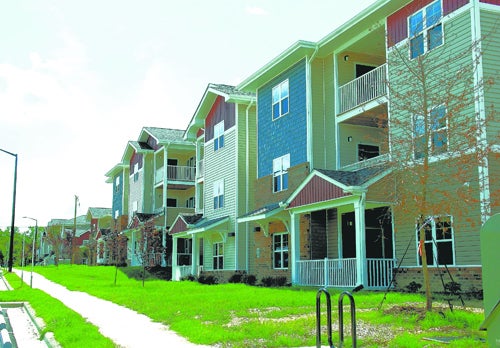Developers, city dedicate Brenner Crossing
Published 12:00 am Tuesday, November 3, 2015

- This August photo shows the completed Phase I of Brenner Crossing, which includes a combination of 80 public housing and tax-credit, affordable apartments.
SALISBURY — Laurel Street Residential, master developer for the redevelopment of the former Civic Park Apartments, in collaboration with the Salisbury Housing Authority and the city of Salisbury, held a grand opening of the new Brenner Crossing Oct. 22.
The dedication of the new mixed-income apartment community Along Brenner Avenue and Standish Street featured several speakers, including Salisbury Mayor Pro Tem Maggie Blackwell and Michael Williams, director of the Greensboro Office of Public Housing.
“We are thrilled to see Phase I of Brenner Crossing completed,” said Dionne Nelson, principal of Laurel Street Residential. “The community offers working families a stable and beautiful place to live.
“Similar to other mixed-income communities we’ve redeveloped across North Carolina that have strengthened their neighborhoods, we expect Brenner Crossing to contribute to the revitalization of the West End community.”
In 2012, the city of Salisbury and SHA were awarded a Choice Neighborhood Planning Grant from the U.S. Department of Housing and Urban Development to develop a Transformation Plan for the West End neighborhood.
As part of that plan, SHA applied for and received an award from HUD’s Rental Assistance Demonstration (RAD) program to redevelop the 80 units at Civic Park Apartments into a 170-unit mixed-income community, including replacing the 80 units at Civic Park.
The new community, renamed Brenner Crossing, brings high-quality, affordable rental housing to a community where it is needed, and it aims to be a complement to revitalization of single-family residences of the West End.
Phase I of Brenner Crossing is comprised of 80 apartments designed for working families at 60 percent of the area’s median income or below. The units are one-, two- and three-bedroom apartments located within two- to three-story garden-style buildings on a 6.38-acre site. Of the 80 units, 36 are supported by a rental assistance contract from HUD, allowing Brenner Crossing to serve families at a broad range of incomes.
Stogner Architecture designed the project. The master site planning was handled by Ramsay, Burgin, Smith Architects and engineering and landscape architecture by Wagoner Consulting Engineers and MLA Design Group.
Construction of Phase I was by Weaver Cooke Construction and R.J. Leeper Construction. Construction of Phase II will be by Miles-McClellan Construction. Several Salisbury-based subcontractors were used for the construction of Brenner Crossing.
“I am thrilled for the residents who formerly lived in the outdated Civic Park apartments, and other new renters, who now have the opportunity to live in some of the prettiest apartments in Salisbury,” said Sam Foust, executive director of the housing authority. “I am very thankful to our development partners, architects, and the investors and lenders who helped SHA to make this possible for the City of Salisbury and Brenner Crossing residents.”
Phase II of the project, which started in September and is slated to be completed in late 2016, will add another 90 new affordable housing apartments and additional amenities. When the second phase is complete, amenities on site will include the following:
• Two children’s playgrounds and picnic areas with grilling stations.
• A tot lot.
• A 3,000-square-foot resident clubhouse with business center, fitness center, kitchen, laundry room, meeting space and screened-in porch.
• An outdoor gazebo
• Recreational open space with connections to the greenway.
• Access to Fibrant, the city’s fiber-optic cable system.
Phase II will consist of townhomes and quadruplexes on a 9.95-acre site encompassing one-, two-, three- and four-bedroom apartments.
Phase I was funded through a $700,000 allocation of federal tax credits by the North Carolina Housing Financy Agency (NCHFA). This tax credit allocation was sold to Red Stone Equity Partners to provide approximately $6 million of equity towards the development, which equates to about 60 percent of the project’s $10 million of total development costs.
Remaining costs were funded by a construction loan from Fifth Third Bank, a permanent loan from The Community Development Trust and subsidized loans from the NCHFA, the Housing Authority of the city of Salisbury, and the city of Salisbury.
The same financial partners will participate in Phase II. Phase I and II combined represent a $24 million investment in the West End community.




